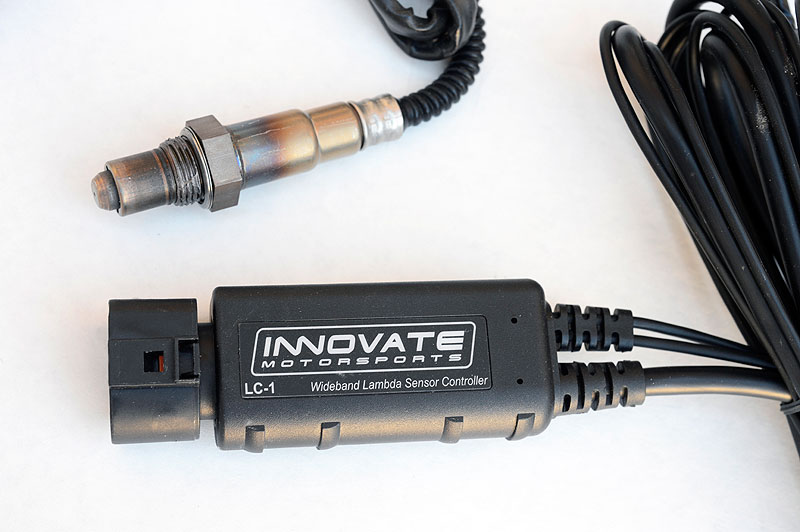Recently, I switched from having an outside vendor do my ECM tuning to the tuning, or, more properly, “calibrating” of my late model cars’ ECMs myself.
To do that I needed calibration software–I acquired HPTuners–and a wide band oxygen sensor and controller–I chose the Innovate Motorsports LC-1. picked the LC-1 because its compact size and impact and moisture resistant case make it easy to move from car to car and allow it to be strapped, taped or clamped in place. It wiring harness length is more than adequate.
An oxygen sensor (O2S) measures the oxygen in exhaust gases. In 1976, the “lambda” or “exhaust gas oxygen” sensor for automotive use was introduced by the Robert Bosch Corporation. Most O2Ses are “narrow-band” devices. They generate 100 to 1000 millivolts, depending on the level of exhaust oxygen, however, their output is linear only in the narrow band of voltages generated when combustion is near stoichiometric. Outside a range of 0.97-1.06-lambda or, on straight gasoline, 14.24–15.56:1 AFR, the signal is nonlinear making useful measurement when the engine is in power enrichment impossible.
Wideband sensors, developed by Bosch in the mid-1990s, vary a reference voltage supplied by a controller. This produces a more linear output such that, given a low level of back pressure, a “wideband” is accurate from 0.34 to 1.51-lambda, or, on gasoline, 5:1-22.17:1 AFR. A wideband is required for calibrating at wide-open throttle (WOT). We ordered Bosch Aftermarket (PN 17014) wide-band sensors from Rockauto.com which worked very well in our testing of the LC-1.
The LC-1 can link to HPTuners’ “MVPI Pro” interface which comes with the VCM Suite. We connected the LC-1, the MVPI Pro, an LED indicator, a push-button and a wiring harness we fabricated according to Innovate’s and HPTuners’ instructions. While Innovate Motorsports supplies data logging software, so we could log wideband and engine controls data together; we configured VCM Scanner, HPT’s data logger, to record the LC-1. Setting up the LC-1 to interface with the MVPI-Pro took an hour or so. The sensor calibration procedure is fairly simple and must be done the first time the LC-1 is used and each time the sensor is changed.
It wasn’t possible to test the Innovate LC-1’s accuracy because we would have needed a very costly laboratory-grade wide-band sensor with which to use for that and we didn’t have access to a high-end WBO2S such as a Horiba. We had seen anecdotal information on a number of Internet forums and read a wideband sensor shoot article which was organized by Westech Performance Group and all indicate that the Innovate Motorsports controllers have an accuracy level high enough for good calibration work but also are available at reasonable cost.
The only problem I had with the LC-1 is, a coupe of times during my evaluation, the controller went “stupid’ sending erroneous data to through the HPT MVPI-Pro to my laptop. At first, I thought this was a case of wideband O2S failure, but later I found that the controller somehow looses its calibration. Running the calibration procedure each time that happened solved the problem.
To date, I have tuned four GM vehicles with the Innovate LC-1, an ’04 Z06, a ’07 Chevy HHR, an ’01 Camaro and a ’99 Blazer and, with one exception noted above, the LC-1 worked very well. Yeah, there are somewhat more sophisticated wide-band controllers which cost a great deal more–we’d all like a Horiba or an ECM–and there are less accurate WBO2s which are cheaper, however, the best compromise between accuracy for practical tuning and cost is the Innovate Motorsports LC-1.
LC-1s are available from Summit Racing

